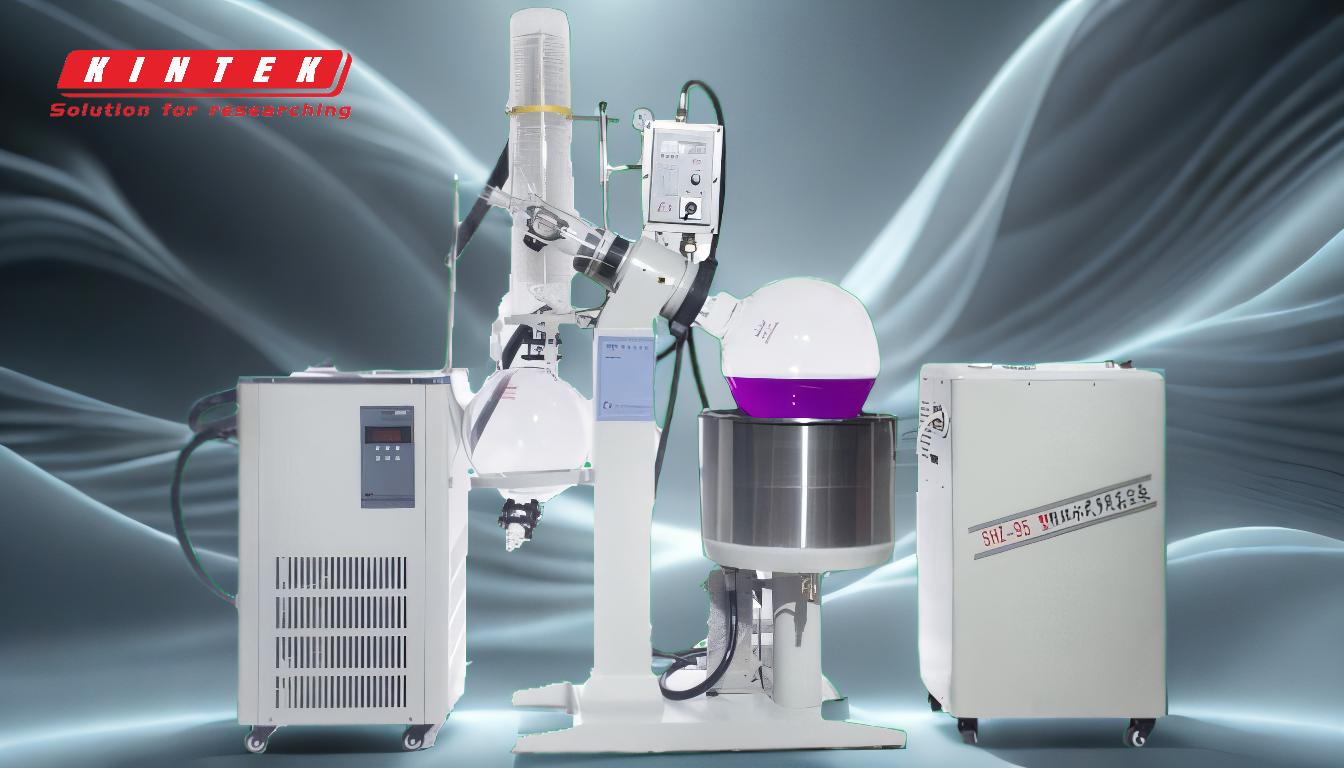Distillation is a widely used separation process that relies on differences in boiling points to separate components of a liquid mixture. The equipment used in distillation varies depending on the type of distillation (e.g., simple, fractional, vacuum, or molecular distillation) and the specific application (e.g., cannabis distillation, chemical purification). Common equipment includes distillation flasks, heat sources, condensers, fractioning columns, vacuum pumps, and specialized systems like wiped film or short-path molecular stills. Each piece of equipment plays a critical role in ensuring efficient separation and purification of the desired components.
Key Points Explained:

-
Distillation Flask
- A round-bottom or distilling flask is a primary component in distillation setups. It holds the liquid mixture to be distilled and is typically heated to induce boiling.
- The flask is connected to other components, such as the condenser and fractioning column, to facilitate the separation process.
- In vacuum distillation, the flask must be compatible with reduced pressure conditions.
-
Heat Source
- A heat source is essential to raise the temperature of the liquid mixture to its boiling point. Common heat sources include:
- Heating mantles
- Hot baths (e.g., water, oil, or sand)
- Direct flames (less common due to safety concerns)
- The choice of heat source depends on the boiling point of the mixture and the required precision in temperature control.
- A heat source is essential to raise the temperature of the liquid mixture to its boiling point. Common heat sources include:
-
Condenser
- A condenser cools the vaporized components, converting them back into liquid form for collection.
- Common types include:
- Liebig condensers (straight-tube design)
- Graham condensers (coiled design)
- Dimroth condensers (double-coil design)
- The condenser is typically connected to a cooling system, such as a chiller or cold water supply.
-
Fractioning Column
- Used in fractional distillation, this column separates components based on their boiling points by allowing repeated vaporization and condensation cycles.
- The column is packed with materials (e.g., glass beads or metal mesh) to increase surface area and improve separation efficiency.
- It is particularly useful for separating mixtures with close boiling points.
-
Vacuum Pump
- A vacuum pump is used in vacuum distillation to lower the pressure inside the system, reducing the boiling points of the components.
- This is especially useful for heat-sensitive compounds that may decompose at high temperatures.
- The pump is connected to the distillation flask and condenser to maintain a consistent vacuum.
-
Wiped Film and Short-Path Molecular Stills
- These are specialized systems used for high-purity distillation, particularly in industries like cannabis (CBD/THC extraction) and chemical manufacturing.
- Wiped Film Still: A thin film of liquid is spread over a heated surface, and a wiper blade ensures even distribution. This design minimizes thermal degradation and maximizes efficiency.
- Short-Path Molecular Still: Operates under high vacuum and short distances between evaporation and condensation surfaces, ideal for separating high-boiling-point or heat-sensitive compounds.
- Both systems often use jacketed vessels heated by oil-circulating temperature control units (TCUs) to achieve precise temperature regulation.
-
Rotary Evaporator
- Commonly used in cannabis distillation to remove solvents like ethanol from concentrates.
- Consists of a rotating flask, condenser, and vacuum pump.
- The rotating motion increases the surface area of the liquid, enhancing evaporation efficiency.
- Often paired with chillers to maintain low temperatures in the condenser.
-
Traditional Distillation Components
- Traditional setups include four main components:
- Heating Bath: Provides controlled heating to the distillation flask.
- Bubble Flask: Holds the liquid mixture and allows vapor to rise.
- Head: Connects the flask to the condenser and may include a thermometer for temperature monitoring.
- Condenser: Cools and condenses the vapor into liquid form.
- Traditional setups include four main components:
-
Temperature Control Units (TCUs)
- TCUs are critical in maintaining precise temperatures during distillation, especially in wiped film and short-path systems.
- They circulate heated oil through jacketed vessels to ensure uniform heating and prevent hot spots.
- Temperature ranges vary depending on the application, with some systems capable of reaching up to 343°C for high-temperature distillations.
-
Receiving Flask
- A receiving flask collects the condensed liquid after it passes through the condenser.
- It is typically placed at the end of the distillation setup and may be swapped out during fractional distillation to collect different fractions.
-
Chillers
- Used in conjunction with condensers and rotary evaporators to maintain low temperatures for efficient vapor condensation.
- Essential for vacuum distillation and solvent removal processes.
By understanding the role of each piece of equipment, purchasers can make informed decisions based on the specific requirements of their distillation processes, whether for industrial, laboratory, or specialized applications like cannabis extraction.
Summary Table:
| Equipment | Purpose |
|---|---|
| Distillation Flask | Holds the liquid mixture and facilitates boiling and vaporization. |
| Heat Source | Provides controlled heating to reach the boiling point of the mixture. |
| Condenser | Cools vaporized components into liquid form for collection. |
| Fractioning Column | Separates components with close boiling points through repeated cycles. |
| Vacuum Pump | Reduces pressure for vacuum distillation of heat-sensitive compounds. |
| Wiped Film/Short-Path Stills | Specialized systems for high-purity distillation in cannabis and chemicals. |
| Rotary Evaporator | Removes solvents efficiently, often used in cannabis distillation. |
| Temperature Control Units | Maintains precise heating for uniform distillation processes. |
| Receiving Flask | Collects condensed liquid after distillation. |
| Chillers | Maintains low temperatures for efficient vapor condensation. |
Need help selecting the right distillation equipment? Contact our experts today for tailored solutions!










